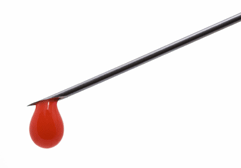Many employers in the waste sector, and many Local Authorities, provide some key rules or action points for use in the event of a sharps (needlestick) injury.
Repeatedly, the need to allow and encourage, but without squeezing, a wound to bleed freely, to wash the wound in soap and water only, and to go immediately to the nearest A&E centre are modified to give only incomplete or misleading, and sometimes frankly incorrect and inapproriate, guidance.
In the event of injury, or of a splash exposure to the face, mouth or eyes, the need to get immediate specialist medical assistance is of great importance. After some basic first aid steps.
Go straight to A&E. Make a fuss, do not accept being left to wait indefinitely or being fobbed off at the initial reception and assessment stage. This isn’t a minor little wound so small it cannot be seen, and you are not being unreasonable to expect urgent treatment. A band-aid, or trip to your GP – if and when you can get an appointment – is just not good enough. And when seen, make even more of a fuss, to be referred urgently to an Infectious Diseases specialist team and not be ‘treated’ only by a junior doctor doing his or her best but unable to provide the necessary specialist assessment and follow-up.
NHS Direct has provided some basic information on their web pages:
About needlestick injuriesMost needlestick puncture wounds involve the hands or feet. Puncture wounds are linked to a higher risk of deep wound infection, which may be caused by infectious organisms that may not easily be removed by washing or treated with self-care. Needlestick injuries often cause significant anxiety as the injured person may fear that they have been infected. The needle may have been contaminated with chemicals, micro-organisms, human blood, other bodily fluids or soil. Therefore it is very important that you follow the advice given to attend your nearest accident and emergency (A&E) department. The A&E department will be able to advise you what you need to do next if there is a possibility you have been infected. In the meantime, there is some first aid advice below. Looking after yourselfFirst aid advice for needlestick injuriesIf you’ve had a needlestick injury, here is some first aid advice to help you before you attend A&E:
|
It’s a great start, with the additional practical tips noted above that should prevent anyone with a sharps injury or splash exposure being fobbed off by A&E. It may be a trivial physical injury but the implications can be profound and speed in assessment and management, where hours can make a real difference, are really important. Don’t let that time slip away.
